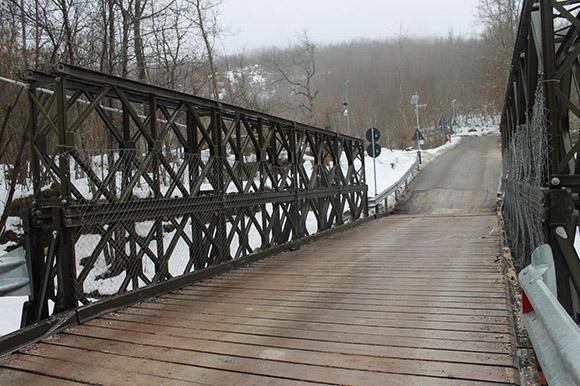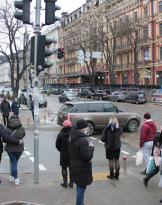"To harsh way to bitter goal": through the roughness up to the stars. A Latin incite that Cicero first and Seneca later knew well. It derives from Greek mythology. It was used for heroes when they were taken to Olympus to die. Being heroes implied having accomplished a series of arduous undertakings. This is, today, the motto of the 6 ° regiment Genius Pioneers of Rome.
The pioneers of the Army, day after day, carry out their work with dedication and a deep sense of humanity, at the service of the population of Amatrice and other communities in Central Italy affected by the earthquake. The human skills of these men and women, with the optimization of the rescue activities highlight both their professional skills and organizational skills.
In the hours following the earthquake the engineers of the Italian Army have worked to restore the road network on the stretches affected by the earthquake. Almost at the same time as the realization of the "Ponte della Rinascita" in the Tre Occhi area, assets of the 6 ° regiment Genius Pioneers of Rome and the 2 ° regiment Genio Pontieri of Piacenza, intervened in Retrosi.
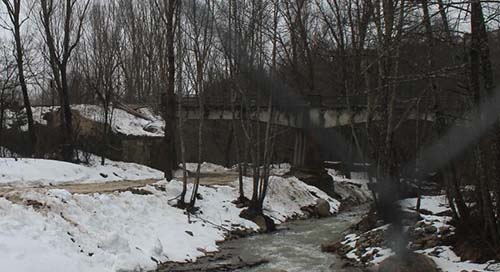 Here is another bridge badly damaged by the repeated shocks of those days until the last of last 18 January.
Here is another bridge badly damaged by the repeated shocks of those days until the last of last 18 January.
Engineers worked manually and on board earth-moving machines to prepare the ground and range of a Bailey bridge.
Il Bailey it is a type of bridge of military origin. The name refers to its creator, the British engineer Donald Bailey. Made with modular elements, or reticular steel beams, decks with wooden planks that speed up the assembly and disassembly that takes place manually or with the use of mobile cranes. It was designed in the 2 World War II to replace the bridges destroyed during the bombing.
A hydrometer is located next to the Bailey bridge in Retrosi. It can be a valid help against the probable dangers to a possible flood of the Tronto river. With the snowfall of the last few days and the continuous rains, the monitoring of the hydrometric levels allows to make predictions on the progress of flood events and consequently to alert the Civil Protection bodies for the rescue activities.
It is a logistic bridge, it allows the transit of heavy vehicles up to 33 tons. It guarantees a way of communication between the common Riminino and the Salaria.
12 kilometers that the school bus runs every morning to accompany the students of Amatrice, Accumoli and hamlets in the new temporary school in the country.

It is a colorful modular building. The school is often said to be like the soul, collects children's dreams. They have lost everything, not the desire to dream to plan the future. Many parents had decided to transfer their children to the schools of Rieti. The teachers insisted that the 200 students return to the Amatrice school. A sign of hope that marks the desire to want to return to a normal life. A small but necessary step for this community. The pioneers of the Army in a few days, with the installation, between steel and cubic meters of concrete laid the foundations of the new building.
The 12 prefabricated modules have been installed by the Civil Defense of the Autonomous Province of Trento. Cover yourself with a perfectly planed fence and painted white, yellow, blue and red. Each color corresponds to a different class: the structure houses the pupils of the kindergarten, primary, middle school and scientific high school of Amatrice and Accumoli. The wooden writing "Trentino" makes me almost forget to be at 955 m altitude in the Gran Sasso and Monti della Laga National Park.
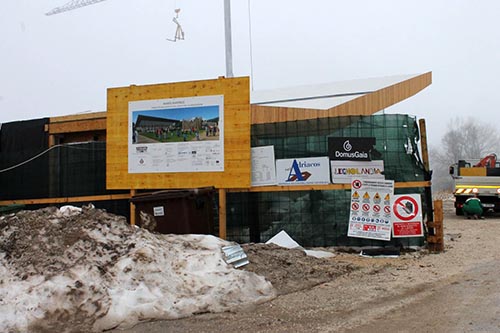 Just in front of the school there is a large construction site for a project created, free of charge, by the architect Stefano Boeri: the Food and Nutrition Pole "AmalaAmatrice". Here too, the 6 ° and other Army departments are working to build the foundations of the planned structure.
Just in front of the school there is a large construction site for a project created, free of charge, by the architect Stefano Boeri: the Food and Nutrition Pole "AmalaAmatrice". Here too, the 6 ° and other Army departments are working to build the foundations of the planned structure.
The idea is born to create an area food, with wooden architecture, such as a large canteen for schools and a multi-purpose space with a huge window, intended for the reopening of collapsed restaurants. Here amatriciani can meet again, meet and relive their traditions, looking towards the Sibillini mountains.
Before arriving at the SAE (Emergency Housing Solutions) along the road that descends towards the village, there is the Multipurpose Community Center "Sant'Agostino". I remember the words that Pope Francis pronounced after praying, walking among the ruins of the center of Amatrice: "You walk better together. Not alone. " The Army is next to these populations tormented by the earthquake, to rebuild the structures necessary to restart the daily life of the Amatricians, who seems to have stopped at the 24 last August.
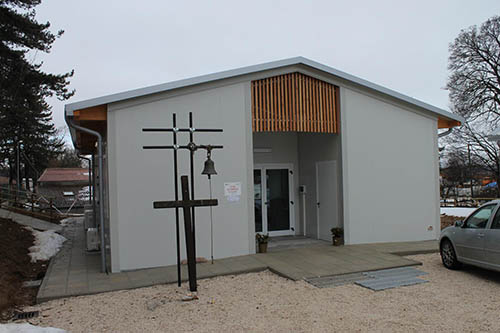 The structure was donated by Caritas to the Amatrice community, and was realized in only 20 days. The wooden cross at the entrance was in Amatrice's cemetery. The module is divided into two parts: a chapel with an altar for mass and a hall where you can make confessions, meetings, or gather for small parties of baptisms and communions.
The structure was donated by Caritas to the Amatrice community, and was realized in only 20 days. The wooden cross at the entrance was in Amatrice's cemetery. The module is divided into two parts: a chapel with an altar for mass and a hall where you can make confessions, meetings, or gather for small parties of baptisms and communions.
Along the way there are houses destroyed like a leopard. Even some of the houses apparently "up to standard", built after the earthquake in L'Aquila, have not held up.
The soldiers of the Genius, in these days, are busy with their specialized structures in realizing the works of primary urbanization that provides for the installation of emergency housing modules, the SAE.
The areas identified in Amatrice for the installation of SAE are 40. The sites are being examined by the Civil Protection which assesses their suitability according to criteria of danger and risk. The response is positive for most of the areas considered suitable, or "eligible with reserve" if these require adjustment work. The Lazio region evaluates the capacity of urbanization of the areas, considering if nearby there are services such as water, electricity, gas, etc. After this phase, the number and type of accommodation to be set up for each area is defined to allow the start of the works and the effective construction of the SAEs. The engineers proceed to the realization of the works of rapid urbanization. They take care of the construction of the area of land: they prepare the foundations. At the same time they prepare the spaces to make connections for utilities such as sewers, water and gas.
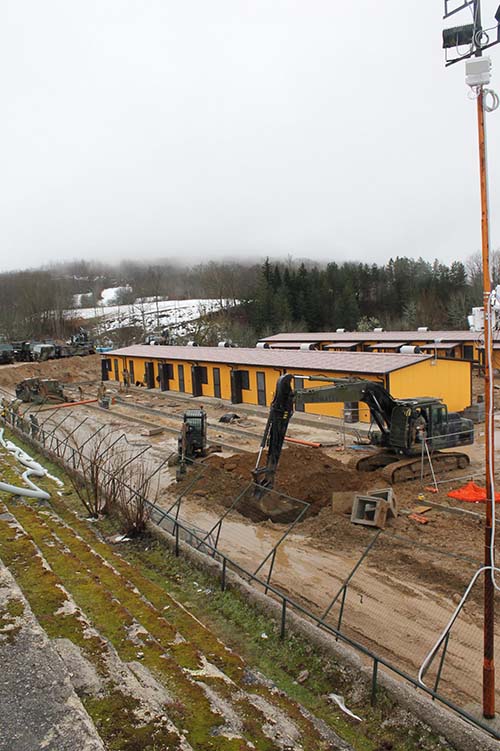 The first "casette" arrived in Amatrice in December at the sports field, Campo Lazio, which houses an accommodation from 80 square meters, 5 from 60 square meters and 19 from 40 square meters. They have already been assigned to Amatrician citizens who have requested it. They are steel modules, combinable with each other, suitable for any weather conditions. Designed to be usable even by disabled people. They are designed in compliance with anti-seismic regulations and with laws on safety, hygiene and the environment. They are equipped with an autonomous heating system consisting of a shared boiler and cast iron radiators. They will be furnished and equipped with household appliances. SAEs are designed to be removed and recovered when they are no longer needed.
The first "casette" arrived in Amatrice in December at the sports field, Campo Lazio, which houses an accommodation from 80 square meters, 5 from 60 square meters and 19 from 40 square meters. They have already been assigned to Amatrician citizens who have requested it. They are steel modules, combinable with each other, suitable for any weather conditions. Designed to be usable even by disabled people. They are designed in compliance with anti-seismic regulations and with laws on safety, hygiene and the environment. They are equipped with an autonomous heating system consisting of a shared boiler and cast iron radiators. They will be furnished and equipped with household appliances. SAEs are designed to be removed and recovered when they are no longer needed.
Despite the not always favorable weather conditions and the prohibitive temperatures, the men and women of the Italian Army work daily, without stopping, until the evening. The goal is to deliver housing as soon as possible.
I leave the sports field construction site. There is a lot of mud. With the officer of the Army in charge of Public Information we head towards the beginning of the historic center: Corso Umberto I. Walking, I notice that some houses will be demolished, others have only some cracks on the outside, they look intact. The supporting structures, in reality, are damaged. Nobody lives there. And those who lived there often come back to check. Who survived wants to defend the few things left. Those houses are the symbol of their daily life devastated by the violence of the earthquake. Upon input from the prefecture, specific inter-departmental vigilance, order and public security services were organized by the Police, Carabinieri, Navy, Air Force and Guardia di Finanza personnel. The Army also deploys a task force to oversee and ensure security outside access points to sensitive areas, bounded as red areas, forbidden to all, except for rescue workers.
The operation Sabina is coordinated with the operation "Safe Roads": other soldiers, in fact, were sent to the central Italian municipalities hit by the earthquake to check the access gates of the red areas. The "specific" crime of looting has never been included in our penal code. With the police forces, the military is engaged in "fixed" surveillance even in isolated and abandoned territories for security reasons. The Italian Army in the "Safe Roads" operation, also in Amatrice, provides specialized personnel, adequate means and equipment to guarantee the safety of people and goods and also support for displaced persons.
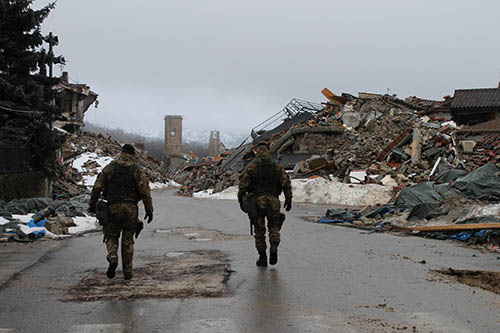 Empty houses are a greedy goal for potential jackals. The earthquake has hit a rather large area and houses are at potential risk. The territory is vast, has many fractions and the presence of paths that link them together, requires more surveillance. This is why we need to monitor and control. Countries and hamlets are patrolled by the various Armed Forces. The Traffic Police guarantees access controls. The Army uses to support the anti-looting activity for the capillary monitoring operations of the areas devastated by the earthquake, in competition with the prefecture and civil protection, the model drones Raven.
Empty houses are a greedy goal for potential jackals. The earthquake has hit a rather large area and houses are at potential risk. The territory is vast, has many fractions and the presence of paths that link them together, requires more surveillance. This is why we need to monitor and control. Countries and hamlets are patrolled by the various Armed Forces. The Traffic Police guarantees access controls. The Army uses to support the anti-looting activity for the capillary monitoring operations of the areas devastated by the earthquake, in competition with the prefecture and civil protection, the model drones Raven.
Il Raven is a mini surveillance aircraft with fixed wing, 140 cm wingspan, weighs about 2 kg with an electro-optical infrared camera. Equipped with autopilot, ground station with ground transmission, live telemetry data and video taken from above. The maximum operating distance is 10 km and has an autonomy of about 90 minutes. The use allows constant patrolling from the top of the red areas of the crater territory and the photogrammetric survey of the areas overflown, from which it is possible to elaborate photographic cadastral maps of the destroyed country. It provides images taken from inside the crumbling buildings that could be targeted by the earthquake's jackals.
The military has for months been a guarantee in support of the populations hit by the earthquake. They remain and will remain by their side to guarantee and restore safety conditions. Their commitment continues to support these people as long as life has a sincere and concrete semblance of normality.
(photo of the author)
Read also the first ("in the heart of Amatrice with the Army") and the second ("with the 6 ° Genius Pioneer regiment") part of the report.

